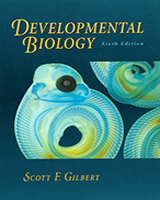By agreement with the publisher, this book is accessible by the search feature, but cannot be browsed.
NCBI Bookshelf. A service of the National Library of Medicine, National Institutes of Health.
Gilbert SF. Developmental Biology. 6th edition. Sunderland (MA): Sinauer Associates; 2000.

Developmental Biology. 6th edition.
Show detailsLike those of mosses and ferns, angiosperm gametes are produced by the gametophyte generation. Angiosperm gametophytes are associated with flowers. The gametes they produce join to form the sporophyte. The study of embryonic development in plants is therefore the study of early sporophyte development. In angiosperms, the sporophyte is what is commonly seen as the plant body. The shoot meristem of the sporophyte produces a series of vegetative structures. At a certain point in development, internal and external signals trigger a shift from vegetative to reproductive (flower-producing) development (see reviews by McDaniel et al. 1992 and Levy and Dean 1998). Once the meristem becomes floral, it initiates the development of floral parts sequentially in whorls of organs modified from leaves (Figure 20.5). The first and second whorls become sepals and petals, respectively; these organs are sterile. The pollen-producing stamens are initiated in the third whorl of the flower. The carpel in the fourth whorl contains the female gametophyte. The stamens contain four groups of cells, called the microsporangia (pollen sacs), within an anther. The microsporangia undergo meiosis to produce microspores. Unlike most ferns, angiosperms are heterosporous, so the prefix micro is used to identify the spores that mitotically yield the male gametophytes—pollen grains. The inner wall of the pollen sac, the tapetum, provides nourishment for the developing pollen.

Figure 20.5
An Arabidopsis flower, illustrating the major organs (petals, sepals, stamen, and carpel) of the typical angiosperm flower. The micrograph on the right shows the dissected flower. Tremendous morphological variation is possible in all four organs; this (more...)
Pollen
The pollen grain is an extremely simple multicellular structure. The outer wall of the pollen grain, the exine, is composed of resistant material provided by both the tapetum (sporophyte generation) and the microspore (gametophyte generation). The inner wall, the intine, is produced by the microspore. A mature pollen grain consists of two cells, one within the other (Figure 20.6). The tube cell contains a generative cell within it. The generative cell divides to produce two sperm. The tube cell nucleus guides pollen germination and the growth of the pollen tube after the pollen lands on the stigma of a female gametophyte. One of the two sperm will fuse with the egg cell to produce the next sporophyte generation. The second sperm will participate in the formation of the endosperm, a structure that provides nourishment for the embryo.

Figure 20.6
(A) Pollen grains have intricate surface patterns, as seen in this scanning electron micrograph of aster pollen. (B) A pollen grain consists of a cell within a cell. The generative cell will undergo division to produce two sperm cells. One will fertilize (more...)
The ovary
The fourth whorl of organs within the flower forms the carpel, which gives rise to the female gametophyte (Figure 20.7). The carpel consists of the stigma (where the pollen lands), the style, and the ovary. Following fertilization, the ovary wall will develop into the fruit. This unique angiosperm structure provides further protection for the developing embryo and also enhances seed dispersal by frugivores (fruit-eating animals). Within the ovary are one or more ovules attached by a placenta to the ovary wall. Fully developed ovules are called seeds. The ovule has one or two outer layers of cells called the integuments. These enclose the megasporangium, which contains sporophyte cells that undergo meiosis to produce megaspores (see Figure 20.4). There is a small opening in the integuments, called the micropyle, through which the pollen tube will grow. The integuments—an innovation first appearing in the gymnosperms—develop into the seed coat, which protects the embryo by providing a waterproof physical barrier. When the mature embryo disperses from the parent plant, diploid sporophyte tissue accompanies the embryo in the form of the seed coat and the fruit.

Figure 20.7
The carpel contains one or more ovules; these contains megasporangia protected by two layers of integument cells. The megasporangia divide meiotically to produce haploid megaspores, All of the carpel is diploid except for the megaspores, which divide (more...)
Within the ovule, meiosis and unequal cytokinesis yield four megaspores. The largest of these megaspores undergoes three mitotic divisions to produce a seven-celled embryo sac with eight nuclei (Figure 20.8). One of these cells is the egg. The two synergid cells surrounding the egg may be evolutionary remnants of the archegonium (the female sex organ seen in mosses and ferns). The central cell contains two or more polar nuclei, which will fuse with the second sperm nucleus and develop into the polyploid endosperm. Three antipodal cells form at the opposite end of the embryo sac from the synergids and degenerate before or during embryonic development. There is no known function for the antipodals. Genetic analyses of female gametophyte development in maize and Arabidopsis* are providing insight into the regulation of the specific steps in this process (Drews et al. 1998).

Figure 20.8
The embryo sac is the product of three mitotic divisions of the haploid megaspore. Two of the nuclei are contained within the central cell; the other six cells contain one haploid nucleus each.
Footnotes
- *
A small weed in the mustard family, Arabidopsis is used as a model system because of its very small genome.
- Gamete Production in Angiosperms - Developmental BiologyGamete Production in Angiosperms - Developmental Biology
- BioAssay, by Gene target for Gene (Select 197131) (1)PubChem BioAssay
Your browsing activity is empty.
Activity recording is turned off.
See more...